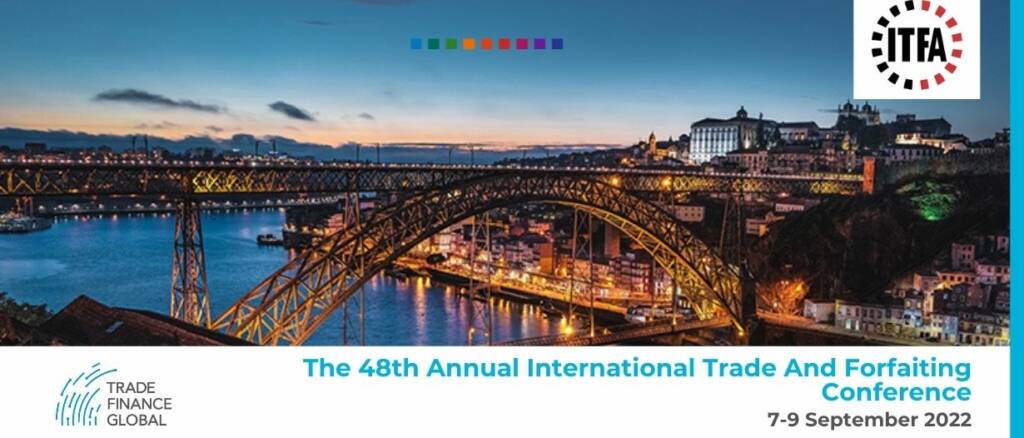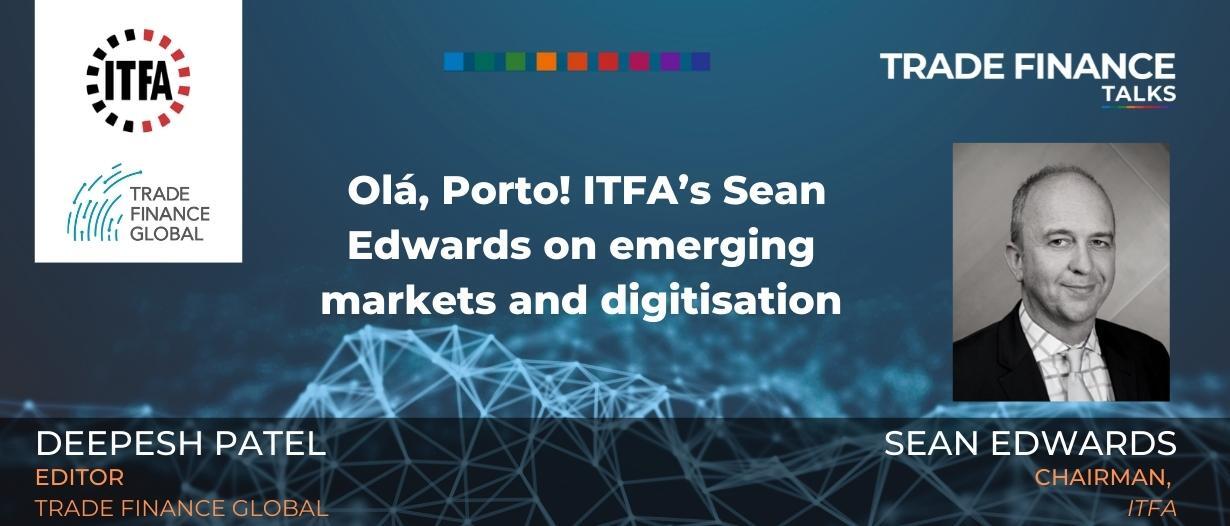Listen to this podcast on Spotify, Apple Podcasts, Podbean, Podtail, ListenNotes, TuneIn
The trade finance industry continues to see significant challenges and changes in 2022.
The effects of COVID-19 have lingered and continued to create ripples in supply chains––a challenge also exacerbated by the current Russia-Ukraine conflict.
The compounded effect of these events has greatly influenced commodities and global trade.
This year, Trade Finance Global (TFG) are proud to once again partner with International Trade and Forfaiting Association (ITFA) at their 48th annual conference in Porto. One year on from last year’s ITFA conference in Bristol (see interview here), TFG’s Deepesh Patel caught up with ITFA’s Chairman, Sean Edwards, to discuss some of the key themes.

Edwards outlined two major themes to be expected at the conference this year: digitisation and emerging markets.
He added that the two shared a crossover, saying, “As we try to improve practices and improve the spread of finance into the emerging markets, one of the best ways of doing that is through digitisation, which is now becoming much more scalable, affordable, and accessible to much smaller players in the emerging market.”
Digitisation as the ‘master key’ in unlocking access to finance in emerging markets
Digitisation has bred a laser focus on driving efficiency in trade finance, in turn aiding the stance of emerging markets.
Of late, interest in emerging markets has come from many sectors. This phenomenon has arisen as a cause of emerging markets’ ability to bring new finance to all industry areas and increased profitability for banks.
Digitisation has been hailed as the best facilitator of growth in this manner, through minimising errors and drawbacks associated with paper-based processes.
This shift towards using electronic trade documents is not an isolated affair; many banks, corporates, financial institutions (FIs) and governments are on board.
A recent example of this was Lloyds Bank’s completion of the UK’s first digital promissory note purchase.
Though this marks a historic moment in the timeline of trade finance, looking towards the future, the next stage will be finding ways to accept and use digital documents in both primary and secondary trade finance markets.
Global trade volumes vs. trade finance lending levels
The current trade landscape has sent a wave of nervousness through banks and FIs, eating away at their appetite to lend, though there has been a spike in optimism as trade volumes begin to rebound to pre-pandemic levels.
Supply chain finance, however, has followed a more complex path.
Despite the industry faring well after the bumpy collapse of Greensill Capital, Edwards added that, following new accounting rules, corporates would now have to be more forthcoming with data, saying, “More disclosure and more information will need to be provided as part of financial statements.”
Environment, Social, Governance (ESG) seems to be a top priority, encouraging businesses to disclose their ESG credentials in their supply chain metrics. On the one hand, this improves pricing as it meets other objectives held by banks, on the other, it poses questions about efficiency and validity.
Despite some claims of ‘greenwashing’ in response to the topic of ESG, there has otherwise been a generally positive response.
Making the supply chain more transparent through the implementation of sustainable measures has opened the doors to other discussions, such as improved pricing as a result of the adoption of ESG metrics.
Once more, this has introduced the topic of digitisation, not only as a ‘greener’ option but also as a solution to errors and delays.
The hope is that these operational changes will aid supply chain banks in their customer service and enhance trust.

A lawful land
The London Interbank Offered Rate (LIBOR), after many decades of being widely used internationally, underwent a cessation earlier in the year––save the exemption of USD-denominated LIBOR.
Months on, after tremendous work of the banks, the USD LIBOR transition is yet to happen, with its publication taking place next year.
Edwards said, “There are still a few holdouts but that [first part of the] process has gone relatively well. It actually is more complicated for some of those currencies, like sterling, than it will be for the dollar.
“This is because the dollar will have a usable term rate for trade.”
He added, “USD LIBOR will still be around for a little while, so I don’t underestimate the work that will need to be done.”
This is not the only legal change that the trade finance industry is undergoing, with the UK seeing the Electronic Trade Documents bill from the Law Commission.
It is believed to come into effect at some point next year, allowing various trade documents–– including bills of lading, promissory notes, bills of exchange, and warehouse certificates––to be accepted when they are in digital form.
Simply, the bill allows for digital forms to possess the same legal weight as their paper counterparts.
Though this is a great step in the right direction Edwards, said, “The question then is how do you create the market in that? How do you show people that you have the right system to digitalise and transfer these instruments once you can legally have them in digital form?”
Showing the reliability of a system through producing guidelines and standards is the surest way of achieving this, and can be seen in the case of Lloyds bank’s first digital promissory note.
Elsewhere, a number of fintechs have begun to work on interoperability, additionally expanding on commercialisation following its legalisation.
Edwards said, “Once we’ve got the right systems, the right platforms, the right vendors, then that’s when we start to get liquidity in.”
Those attending the conference can look forward to panels addressing many of these themes and ample networking opportunities.
TFG are a proud partner of ITFA’s 48th Annual Trade Conference in Porto, find out more here.

































